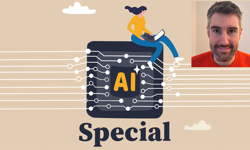
How much time in the last six months have you spent trying to understand your consumer? Quite a lot, I suspect.
Now imagine there is a technology out there that will save you time and money when trying to understand your consumer and not only that, it will give you the time back to be creative and innovative with data-led insight.
What am I talking about? Artificial Intelligence.
AI is intelligent machines that work and react like humans. Artificial intelligence is about allowing machines to continuously learn from our behaviours and interactions in order to improve the way 'digital' environments support our lives.
Practically, though, before you begin implementing a programme of AI-based optimisation, it’s important to understand where it can help you and understand where the opportunities lie. Look at the business benefits which span marketing, finance and ultimately, when executed correctly… innovation.
For me, the most valuable aspect of AI sits directly with marketing. AI applications can harness data from an array of sources and from that data, it can define new unexpected patterns and then act on undiscovered opportunities. Consider being able to respond to unique customer behaviours that had previously gone unnoticed and develop stronger connections with your customers because of it. The access to such insightful data is providing more measurability and accountability than ever, which greatly improves the effect and efficiency of marketing.
AI enables automation and thus the intelligent personalisation of messaging based on the interests and behaviours of consumers. This will ultimately change the way that we present websites, reward programmes, emails and advertising to our consumers. While I am sure that we all use a degree of personalisation in our marketing, AI offers consumer insight that we previously haven’t been able to consider… it’s learning consumer behaviour in a way that we can’t manually do and that is what makes it so valuable to marketers. We are finally learning micro triggers and nuances that we could not have predicted and may have missed altogether.
AI can define new unexpected patterns and then act on undiscovered opportunities.
Always on
AI can be constantly monitoring all the various marketing channels and provide relevant responses into each channel according to the activity. There is a great deal of flexibility offered, from paid media to social community management, and AI could be responsible for ensuring that the conversation is always in the favour of positive resolution with consumers. For example, if an AI is scanning a social platform that is seen to be building up negative sentiment to your brand, it could then interject with pacifying replies and help to shape the conversation in more positive ways.
AI obviously brings the advantage of being continuously on – meaning businesses could host a central marketing team, with the ability to manage international deployment; expansion suddenly isn’t so daunting!
In terms of publishing specifically, in the short term, AI can greatly improve the targeting of marketing and awareness drives. By combining customer, CRM data with search and social analytics, it will be possible to deliver far more engaging communications taking integrated marketing to a new level of complexity.
Take that one step further by applying AI within the digital magazines themselves and it could enable the advertising to be dynamic, being presented depending on a person’s profile and interests. This will increase ad engagement to conversion results and open more commercial revenue opportunities. Longer term opportunities lie in areas like personalised publishing, the advent of the individual magazine, tailored just for me – combining a range of my personal tastes into one highly tailored and personalised piece of content.
AI enables automation and thus the intelligent personalisation of messaging based on the interests and behaviours of consumers.
Extension not replacement
Now, where does AI fit in terms of finance? There are obviously cost saving implications if you effectively implement an AI programme. AI is taking on the hard work – no more manually crunching the data and trying to find the opportunities – it’s doing that for you. But, ultimately, AI should be an extension of your team. It should not be your team – I’ve said this over and over again and I need to hammer home the point. The efficiencies that AI brings means that overall reach and marketing effectiveness is increased but it’s not a person; there is no emotional connection. Remember that while you can feed artificial intelligence with as much data as is out there, it will not be able to identify those things that make us human. AI does not replace human creativity or our understanding of the nuances of our business. AI needs managing, it needs direction, prioritisation and continual analysis to prevent catastrophes. It needs validation from human insight and that creative input. And finally, this tech is still very much in its infancy, so there is a big risk of over-automation, where customers can react negatively to the lack of humanness.
From a revenue perspective, if you’re reaching more of the right people, you’re going to impact the bottom line. That’s what we want; we want more consumers reading our magazines but we also want to know that the magazines are being read by the right people.
AI should be an extension of your team. It should not be your team.
Innovation
Finally, we come to innovation. AI gives us the confidence to innovate. With the ability to test, learn and react fast, it empowers us to be more experimental and, for some, introduce more dynamism into how we market to our consumers.
When you think of innovation – are you looking for ‘the next big idea’? Or simply, to do things in a way that is new and different? Innovation, in relation to AI, fits into two clear streams.
The first is ‘Innovation in Business’. This is the processes and systems we follow as part of our day to day management and using AI to change the way that things have conventionally been done in marketing and business intelligence. As we’ve covered earlier, with so much learning, you have a plethora of informed knowledge that you can overlay onto business practice.
Uber is a great example of a company that uses AI to enhance its business processes and that’s simply because AI is at the heart of how the company operates. They use it to predict rider demand so that they can get to a point where they no longer need to use ‘surge pricing’ during periods of high demand, ultimately putting the consumer first.
Alongside innovation in business, you’ve then got product innovation which essentially means using AI to enhance an actual product or service that we offer. Practical examples help bring this to light: your email inbox probably seems like an unlikely place for AI, but the technology is largely powering one of its most important features: the spam filter. Spam filters must continuously learn from a variety of signals, such as the words in the message, message details, message origin and so much more to be able to determine what is spam and what is not. Simple rule based filters are not enough anymore because it’s so easy to manipulate these.
AI isn’t just the future, it’s the present too… but it’s the future where the real opportunities lie.
AI needs managing, it needs direction, prioritisation and continual analysis to prevent catastrophes.
AI-first
Google recently pivoted from a ‘mobile-first’ approach to an ‘AI-first’ one, and it’s a real game-changer. Over the last decade, the biggest tech companies have concentrated their efforts on making smartphones the gateway to our digital lives. However, by switching focus to AI and machine learning, Google is acknowledging that AI is the new future and those companies that fail to invest now risk falling behind the curve.
The popularity of Siri, Alexa and Cortana have made people comfortable with talking to a machine. By replacing typing, voice is slowly changing the way people search online. For instance, very few people type the way they speak, especially when it comes to search queries. Therefore, when optimising websites for customer-based queries, businesses need to account for the more conversational way people talk in comparison to typing.
There are also risks we need to consider… we have already seen AI bots learn bad habits and having to be shut down. Alongside this, the challenge is to ensure the tech is seen as a tool and not a replacement – it will be easy for ‘our financial colleagues’ to look at the cost efficiency that AI offers, and complacently see it as an alternative plug and play marketing team.
What I hope you have taken from this is that AI is an opportunity and it’s our job to understand how to use this to our benefit to give our consumers exactly what they want even when they don’t realise they want it.
Think about where you could implement artificial intelligence into your marketing strategy. That could simply be using smart shopping if you don’t already do so or consider how voice search is going to impact the content that you offer to consumers. You could also consider how chatbots could impact your customer service offering.
Remember, it’ll always need a human to oversee it, but it should create efficiencies and allow time for innovation. AI gives us the freedom to be creative and strategic rather than being the doers.
AI is the new future and those companies that fail to invest now risk falling behind the curve.
This article was first published in InPublishing magazine. If you would like to be added to the free mailing list, please register here.












